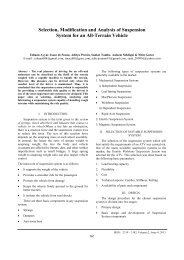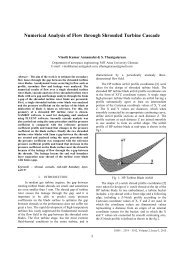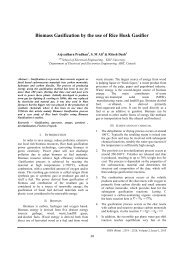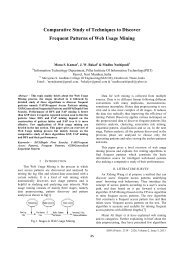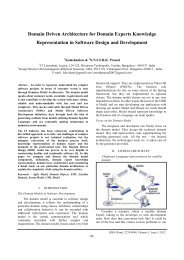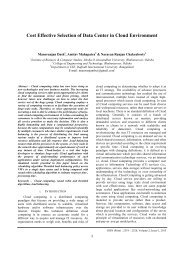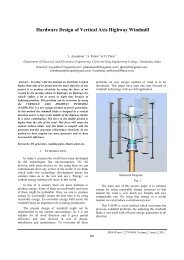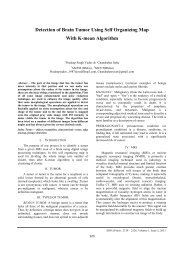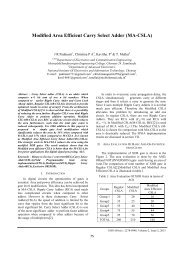Transient Stability Analysis Using MATLAB Simulink and ... - IRD India
Transient Stability Analysis Using MATLAB Simulink and ... - IRD India
Transient Stability Analysis Using MATLAB Simulink and ... - IRD India
You also want an ePaper? Increase the reach of your titles
YUMPU automatically turns print PDFs into web optimized ePapers that Google loves.
International Journal on Advanced Computer Theory <strong>and</strong> Engineering (IJACTE)Fig 13 ang v/s time response of smib system with dampingwith neural network implemented in systemFig 12 shows that with same critical clearing timeour torque angle is limited to 50 degree in case of neuralnetwork as compare to 55 degree in case of time domainsolution. So nueral network can give better results whenused. Fig 13 shows the damping introduced into thesystem when neural network is implemented into thesystem. The results are even better in this case ascompared to time domain solutionVI. CONCLUSIONThe results shows that transient stability can becalculated with artificial neural network. The outputobtained from both the result are almost identical <strong>and</strong>best suited for transient stability stability analysis. Inthis paper smib system is simulated on matlab <strong>Simulink</strong><strong>and</strong> output generated from this <strong>Simulink</strong> work as theinput for neural network training <strong>and</strong> the result obtainedare compared. <strong>Transient</strong>s present in the system are alsobeen removed by providing damping into the system.VII. REFERENCES[1] P. kundur, j. paserba, v. ajjarapu, g. <strong>and</strong>erson, a.bose, c.canizares, n. hatziargyriou, d. hill, a.tankovic, c. taylor, t. v.cutsem, <strong>and</strong> v. vittal,“definition <strong>and</strong> classification of powersystemstability,” ieee trans. power syst., vol. 19,no. 3, pp. 1387–1401,aug. 2004.[2] N.amjady <strong>and</strong> s.f.majedi,2007, “transient stabilityprediction by a hybrid intelligent system”,ieeetransactions on power systems, vol 22, no. 3[3] P. kundur, “power system stability <strong>and</strong> control,”in the epri power system engineering series. newyork: mcgraw hill, 1994.[4] Z. racz <strong>and</strong> b. bokay, “power system stability”.new york: elsevierscience, 1988.[5] Noor izzri abdul wahab, azah mohamed <strong>and</strong> ainihussain, “an improved method in transientstability assessment of a power system usingprobabilistic neural network” journal of appliedsciences research, 3(11): 1267-1274, 2007[6] N. amjady <strong>and</strong> m. ehsan, “transient stabilityassessment of power systems by a new estimatingneural network,” can. j. elect. comp.eng., vol. 22,no. 3, pp. 131–137, jul. 1997.[7] C. w. liu, m. c. su, s. s. tsay, <strong>and</strong> y. j. wang,“application of a novel fuzzy neural network toreal-time transient stability swings predictionbased on synchronized phasor measurements,”ieee trans.power syst., vol. 14, no. 2, pp. 685–692, may 1999.[8] N. amjady, “application of a new artificial neuralnetwork in transient stability assessment,” inproc. ieee lescope conf., halifax, ns, canada, jun.1999, pp. 126–132.[10] Noor izzri abdul wahab, azah mohamed <strong>and</strong> ainihussain,, “an improved method in transientstability assessment of a power system usingprobabilistic neural network” journal of appliedsciences research, 3(11): 1267-1274, , 2007.[11] Sanyal, k. k., “transient stability assessment usingneural network”. ieee international conference onelectric utility deregulation, restructuring <strong>and</strong>power technologies, hong kong, 633-637, 2004.[12] Bettiol, a.l., a. souza, j.l. todesco, j. tesch, r jr.,“estimation of critical clearing times using neuralnetworks”. proc. ieee bologna power techconference, 3: 6, 2003.[13] Power system engineering Nagrath & Kothari,page no559-634, page no 981-988138ISSN (PRINT) : 2320 – 8945, Volume -1, Issue -6, 2013



